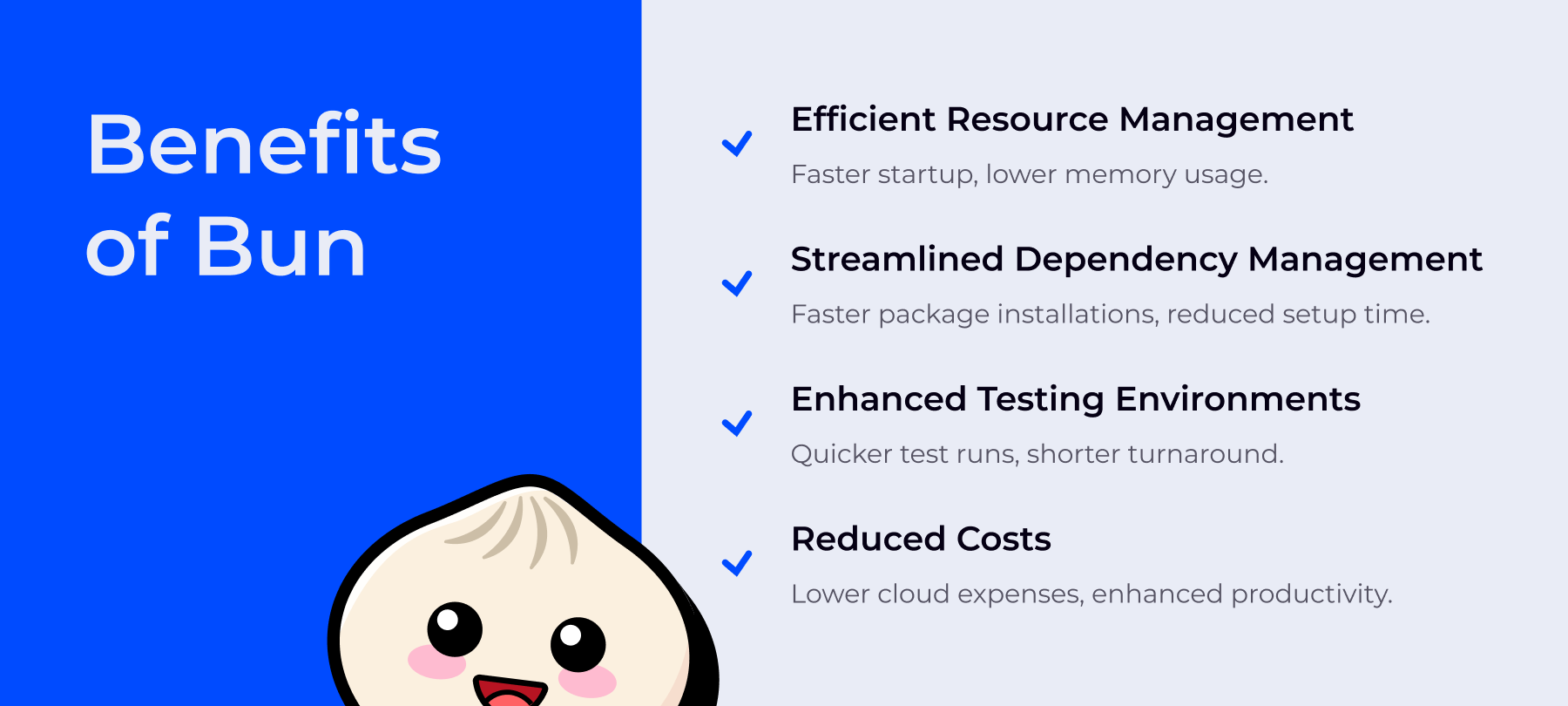Continuous Integration (CI) is a pivotal strategy for driving project success and delivering superior software solutions. It ensures code integrity, accelerates development cycles, and enhances overall software quality.
But, in large-scale projects it takes a lot of time and money.
So how to reduce costs of CI? How can Bun help with that? And how to implement it efficiently?
Let’s explore in a blog post by our expert Augusto Amaral, Software Engineer at Zoolatech.
Having a CI that integrates with your projects completely, allows you to automate all the processes that come from the machine of the developer until they are deployed in production and ready for usage. This includes:
- identifying changes on the codebase,
- running all the automated tests for your project,
- checking for failures or differences,
- managing all the credentials,
- connecting to the deployment server and finally deploying to the production.
Clients stand to benefit significantly from CI in the long run. Firstly, CI ensures early detection of bugs and integration issues, minimizing the risk of costly errors in production environments.
Secondly, it facilitates faster feedback loops, allowing teams to iterate swiftly and deliver features more efficiently.
Moreover, CI promotes greater transparency and predictability in project timelines, enabling clients to make informed decisions and adapt to evolving requirements with ease;
But believe it, it’s not easy or fast.
This process can consume a lot of time, particularly the testing phase, which requires simulating an environment akin to both the developer’s and production environments and running all the system tests.
In the case of a Node project, the setup phase alone can exceed a minute. While a minute may not seem significant, consider a scenario with 15 developers actively coding and making at least two new commits daily. If you spend a minute for each instance, you’ll exhaust 30 minutes daily on a cloud instance solely installing dependencies, without even beginning the testing phase.
The challenge with CI lies in its associated costs. As projects expand, so do the expenses incurred from running a NodeJS instance, installing all dependencies, and executing tests. These costs can escalate exponentially based on the size of your project.
However, despite the costs, this investment is worthwhile because having a bug in production is unequivocally unacceptable.
Why choose Bun over NodeJS? Bun is an all-in-one toolkit for JavaScript and TypeScript apps.
It’s similar to NodeJS, yet there’s a crucial difference that sets it apart. At its core is the Bun, a rapid JavaScript runtime crafted as a drop-in replacement for Node.js. Written in Zig and powered by JavaScriptCore under the hood, it significantly diminishes startup time and memory usage.
There are several reasons why Bun might prove beneficial for your project:
Efficient Resource Management
One of Bun’s standout features, compared to Node.js, is its efficiency in resource management. Thanks to its design and the capabilities of the Zig programming language, Bun exhibits significantly faster startup times and lower memory usage.
This characteristic directly correlates to cost savings and increased efficiency in CI pipelines.
In CI processes, time and resources are critical factors. With Bun, the time elapsed from code commit to deployment can be substantially minimized. This efficiency is especially evident in projects with multiple integrations and a large number of automated tests.
Streamlined Dependency Management
Bun introduces a more streamlined approach to handling package installations through its integrated package manager. It’s engineered to be faster than npm and yarn, the commonly used package managers with Node.js.
In the context of CI, where every second is critical, the speed at which dependencies are installed and resolved can profoundly affect the overall duration of the CI pipeline.
The expedited setup phase translates to reduced build times, resulting in more efficient utilization of CI resources and shorter feedback cycles for developers.
Enhanced Testing Environments
CI heavily depends on automated tests to uphold code quality and prevent bugs from infiltrating production. Bun’s fast startup time and efficient execution environment contribute to quicker test runs.
This is especially advantageous for extensive test suites or projects requiring tests to run in isolated environments.
With Bun, faster test execution leads to shorter turnaround times for developers, facilitating more frequent integrations and deployments.
Reduced costs
The direct cost savings come from decreased compute time in cloud environments, where resources are billed based on usage. By reducing the time needed for CI processes, Bun can result in lower cloud computing expenses. Furthermore, the indirect cost savings from enhanced developer productivity and shortened time to market for new features or fixes are equally significant.

It sounds promising! How to get started?
While Bun can be implemented in various ways, the simplest and most basic approach is to utilize Bun solely for dependency installation.
This can notably reduce installation time, as the command is implemented in Zig, featuring a custom HTTP client. This allows for multi-threaded, parallel downloading of multiple packages, minimizing latency compared to a single-threaded Node.js script.
Following the initial implementation, Bun can be employed for executing customary CI tasks, such as running test suites or initializing clients for other purposes.
In the fast-paced realm of software development, efficiency, speed, and cost-effectiveness are key. Bun’s design philosophy and technical advantages present a compelling alternative to Node.js, especially within Continuous Integration contexts.
By enhancing the speed and efficiency of the CI pipeline, Bun not only diminishes operational costs but also elevates developer productivity and project agility.
Several examples demonstrate Bun’s superior speed and efficiency, accompanied by numerous benchmark tests available in their repository. If you’re uncertain about any of the points mentioned, don’t hesitate to try it yourself and witness the impressive results firsthand.
Experience the satisfaction of operating on a faster and more cost-effective infrastructure for you and your team!
It’s important to note that Bun is still undergoing development, and future changes are likely. Depending on the scale of your project, this may present some challenges, so proceed with awareness.
If you have any further questions, please contact our experts!
